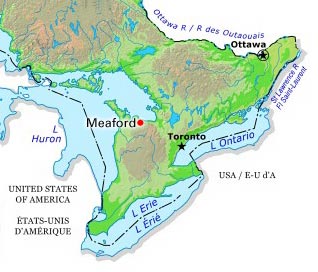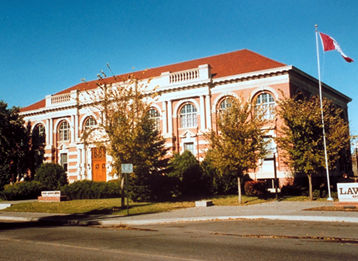Article
Meadow Lake
During the 1930s many farmers deserted land in the "dust bowl" and moved N to start again. Meadow Lake was a popular destination, and the arrival of a CPR line in 1936 provided an opportunity for further development.

Enter your search term
Signing up enhances your TCE experience with the ability to save items to your personal reading list, and access the interactive map.
Create AccountArticle
During the 1930s many farmers deserted land in the "dust bowl" and moved N to start again. Meadow Lake was a popular destination, and the arrival of a CPR line in 1936 provided an opportunity for further development.
"https://www.thecanadianencyclopedia.ca/images/tce_placeholder.jpg?v=e9dca980c9bdb3aa11e832e7ea94f5d9" // resources/views/front/categories/view.blade.phphttps://www.thecanadianencyclopedia.ca/images/tce_placeholder.jpg?v=e9dca980c9bdb3aa11e832e7ea94f5d9

Article
Meaford, Ont, incorporated as a municipality in 2001, population 11 100 (2011c) 10 948 (2006c). The Municipality of Meaford was a town (incorporated in 1874) until 2001 when it was amalgamated with St Vincent and Sydenham townships to create the Municipality of Meaford
"https://d3d0lqu00lnqvz.cloudfront.net/media/media/2fa20b37-d822-4528-b9b5-d99acf454bfc.jpg" // resources/views/front/categories/view.blade.phphttps://d3d0lqu00lnqvz.cloudfront.net/media/media/2fa20b37-d822-4528-b9b5-d99acf454bfc.jpg

Article
Medicine Hat, Alberta, incorporated as a city in 1906, population 63,271 (2021 census), 63,260 (2016 census). The city of Medicine Hat is one of Alberta's largest cities. It is located on the Canadian Pacific Railway main line and the Trans-Canada Highway in the southeastern corner of the province, bisected by the South Saskatchewan River. Canada's “sunniest” city, Medicine Hat averages 330 days of sunshine per year. A council of eight councillors and a mayor govern the city.
"https://d3d0lqu00lnqvz.cloudfront.net/media/media/3897d8ea-97cb-4069-8f58-433a41de83d2.jpg" // resources/views/front/categories/view.blade.phphttps://d3d0lqu00lnqvz.cloudfront.net/media/media/3897d8ea-97cb-4069-8f58-433a41de83d2.jpg

Article
The rail line, which arrived in 1909, made Melfort a trade and cultural centre for the surrounding area. It was incorporated as a village in 1903, as a town in 1907 and a city in 1980.
"https://www.thecanadianencyclopedia.ca/images/tce_placeholder.jpg?v=e9dca980c9bdb3aa11e832e7ea94f5d9" // resources/views/front/categories/view.blade.phphttps://www.thecanadianencyclopedia.ca/images/tce_placeholder.jpg?v=e9dca980c9bdb3aa11e832e7ea94f5d9

Article
The community's growth beyond that of others in the area came as a result of its designation as a divisional point by the railway. The importance of the railway has since been balanced somewhat by the city's role as a service centre for the poultry, livestock and grain farmers in the area.
"https://www.thecanadianencyclopedia.ca/images/tce_placeholder.jpg?v=e9dca980c9bdb3aa11e832e7ea94f5d9" // resources/views/front/categories/view.blade.phphttps://www.thecanadianencyclopedia.ca/images/tce_placeholder.jpg?v=e9dca980c9bdb3aa11e832e7ea94f5d9

Article
Merrickville-Wolford, Ont, incorporated as a village in 1998, population 2850 (2011c), 2867 (2006c). The Village of Merrickville-Wolford is located on the Rideau River, 55 km southwest of Ottawa.
"https://www.thecanadianencyclopedia.ca/images/tce_placeholder.jpg?v=e9dca980c9bdb3aa11e832e7ea94f5d9" // resources/views/front/categories/view.blade.phphttps://www.thecanadianencyclopedia.ca/images/tce_placeholder.jpg?v=e9dca980c9bdb3aa11e832e7ea94f5d9

Article
Merritt, BC, incorporated as a city in 1981, population 7113 (2011c), 6998 (2006c). The City of Merritt is located in the Nicola Valley of south-central British Columbia, at the junction of the Coldwater and Nicola rivers, 88 km southof Kamloops on the COQUIHALLA HIGHWAY.
"https://www.thecanadianencyclopedia.ca/images/tce_placeholder.jpg?v=e9dca980c9bdb3aa11e832e7ea94f5d9" // resources/views/front/categories/view.blade.phphttps://www.thecanadianencyclopedia.ca/images/tce_placeholder.jpg?v=e9dca980c9bdb3aa11e832e7ea94f5d9

Article
Metchosin, British Columbia, incorporated as a district municipality in 1984, population 4,708 (2016 census), 4,803 (2011 census). The District of Metchosin is located on Vancouver Island. It overlooks the Juan de Fuca Strait. Metchosin is part of the Greater Victoria area. From the late 1800s to 1958, a quarantine station operated at William Head in Metchosin. Many immigrants arriving to Canada by ship were quarantined at William Head before being allowed to enter the country. This was done in an effort to prevent the spread of infectious diseases common on overcrowded ships. In addition, from 1924 to 1956, there was a leper colony on nearby Bentinck Island.
"https://d3d0lqu00lnqvz.cloudfront.net/media/media/853b5d41-e9b6-4b2e-a205-03a54f80d5b2.jpg" // resources/views/front/categories/view.blade.phphttps://d3d0lqu00lnqvz.cloudfront.net/media/media/853b5d41-e9b6-4b2e-a205-03a54f80d5b2.jpg

Article
Road allowance communities were home to Métis families throughout the late 1800s until the mid- to late 1900s. Métis peoples used the road allowances as new home communities after experiencing relocations, migrations and dispossession from their homelands. After resistance and violence in a period during and after the Riel Resistance of 1869–1870 and the North–West Resistance in 1885, Métis were marginalized and labelled as rebellious or troublesome by the government of Canada and the provinces.
"https://d3d0lqu00lnqvz.cloudfront.net/media/media/RoosterTownFamily.jpg" // resources/views/front/categories/view.blade.phphttps://d3d0lqu00lnqvz.cloudfront.net/media/media/RoosterTownFamily.jpg

Article
Métis communities are found in many provinces and territories in Canada; however, the only legislated Métis land base is in Alberta. Eight Métis settlements are located across the northern and central-eastern part of the province: Paddle Prairie, Peavine, Gift Lake, East Prairie, Buffalo Lake, Kikino, Elizabeth and Fishing Lake. As of 2021, the settlements cover 1.25 million acres of land and are home to approximately 4,238 people. That year, 3,540 people reported that they were registered members of Métis Settlements in Alberta. The Métis Settlements are self-governing and provide for the protection of Métis culture and identity.
"https://d3d0lqu00lnqvz.cloudfront.net/MetisSettlementsFlag/Metis_Settlements_Flag.gif" // resources/views/front/categories/view.blade.phphttps://d3d0lqu00lnqvz.cloudfront.net/MetisSettlementsFlag/Metis_Settlements_Flag.gif

Article
Middleton, NS, incorporated as a town in 1909, population 1749 (2011c), 1829 (2006c). The Town of Middleton is located in Nova Scotia's historic ANNAPOLIS VALLEY.
"https://d3d0lqu00lnqvz.cloudfront.net/media/media/bcfd90ed-d214-45b6-8e09-5896fdf32004.jpg" // resources/views/front/categories/view.blade.phphttps://d3d0lqu00lnqvz.cloudfront.net/media/media/bcfd90ed-d214-45b6-8e09-5896fdf32004.jpg

Article
Midland, Ont, incorporated as a town in 1890, population 16 572 (2011c), 16 330 (2006c). The Town of Midland is located on Midland Bay, an inlet of Georgian Bay. It is about 145 km by road north of Toronto.
"https://d3d0lqu00lnqvz.cloudfront.net/media/media/16b8b94b-0ca0-468a-8f8f-09141c3462be.jpg" // resources/views/front/categories/view.blade.phphttps://d3d0lqu00lnqvz.cloudfront.net/media/media/16b8b94b-0ca0-468a-8f8f-09141c3462be.jpg

Article
Milton, Ontario, incorporated as a town in 1857, population 132,979 (2021 census), 110,128 (2016 census). One of four municipalities in Halton Region, Milton’s odd shape means it shares a border with six communities. Milton’s modern borders were created in 1974, from Nassagaweya Township, the Town of Milton, and parts of Esquesing, Trafalgar, and Nelson townships. Throughout history, the Milton area has been home to different Indigenous groups, namely the Neutral, Huron-Wendat, Haudenosaunee and Anishinaabeg, including the Mississauga. The land is within treaties 3 ¾, 14, and 19 (see Upper Canada Land Surrenders).
"https://d3d0lqu00lnqvz.cloudfront.net/media/new_article_images/Milton/MiltonDowntown.jpg" // resources/views/front/categories/view.blade.phphttps://d3d0lqu00lnqvz.cloudfront.net/media/new_article_images/Milton/MiltonDowntown.jpg

Article
Minnedosa, Man, Manitoba, incorporated as a town in 1883, population 2587 (2011c), 2474 (2006c). The Town of Minnedosa is located 205 km northwest of Winnipeg, on the east side of the Little Saskatchewan River.
"https://www.thecanadianencyclopedia.ca/images/tce_placeholder.jpg?v=e9dca980c9bdb3aa11e832e7ea94f5d9" // resources/views/front/categories/view.blade.phphttps://www.thecanadianencyclopedia.ca/images/tce_placeholder.jpg?v=e9dca980c9bdb3aa11e832e7ea94f5d9

Article
Minto, NB, incorporated as a village in1962, population 2505 (2011c), 2681 (2006c). It is located 56 km north of Fredericton in the Minto coalfields.
"https://www.thecanadianencyclopedia.ca/images/tce_placeholder.jpg?v=e9dca980c9bdb3aa11e832e7ea94f5d9" // resources/views/front/categories/view.blade.phphttps://www.thecanadianencyclopedia.ca/images/tce_placeholder.jpg?v=e9dca980c9bdb3aa11e832e7ea94f5d9
